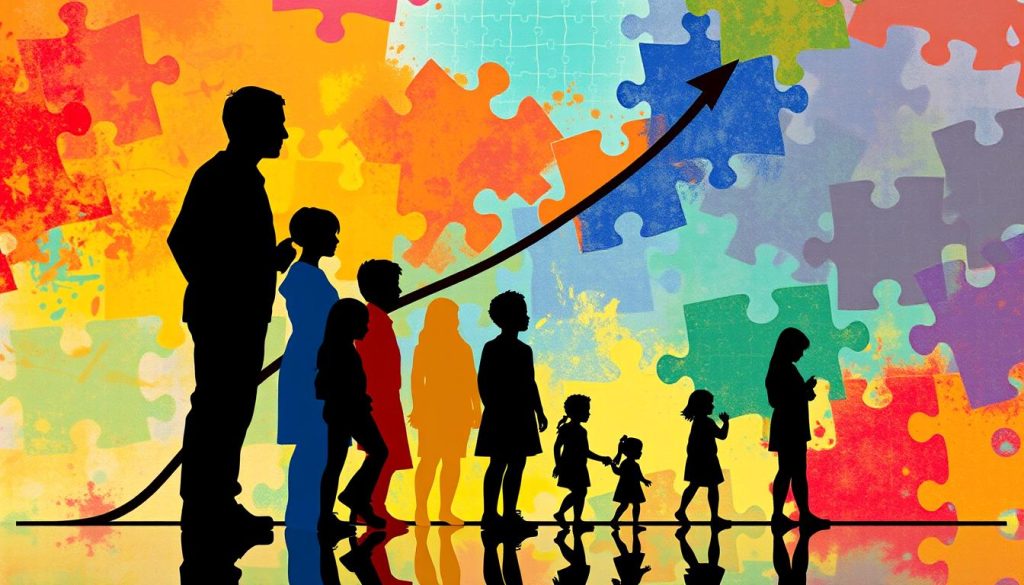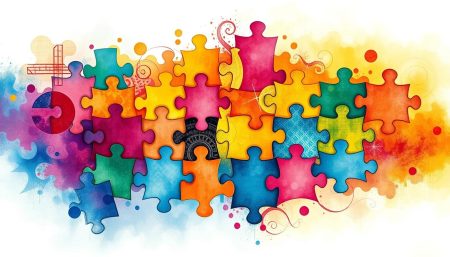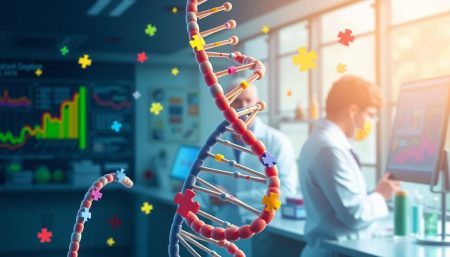Autism spectrum disorder (ASD) rates have been climbing steadily over the past few decades. This rise in autism prevalence has sparked concern and curiosity among parents, healthcare professionals, and researchers alike. Understanding the factors behind increasing autism rates is key for developing effective strategies to support those affected by ASD.
As we explore the complex world of autism spectrum disorder trends, we’ll look at various aspects that may contribute to this phenomenon. From improved diagnostic methods to environmental influences, the reasons behind the surge in autism cases are complex and often intertwined.
By examining these factors, we aim to shed light on the current state of autism diagnosis and treatment. This knowledge is essential for families, educators, and policymakers working to address the needs of individuals with ASD in our communities.
Historical Trends in Autism Diagnosis
The number of autism diagnoses has grown a lot in recent years. To understand this, we need to look at how we recognize and classify autism today.
Early Recognition and Classification
Autism was first talked about in the 1940s. But it took a while for it to be widely known. Back then, autism was often mixed with other conditions. This made it harder to track how common it was.
Evolution of Diagnostic Criteria
The way we diagnose autism has changed a lot. Each update to the Diagnostic and Statistical Manual of Mental Disorders (DSM) has made the definition of autism wider. This change is a big reason for the increase in autism cases.
Statistical Patterns in Reporting
As more people became aware and the criteria got broader, more cases of autism were reported. Here are some key statistics:
| Year | Prevalence Rate | Key Change |
|---|---|---|
| 1970s | 1 in 10,000 | Limited awareness |
| 1980s | 1 in 2,500 | Autism in DSM-III |
| 2000s | 1 in 150 | Broader criteria |
| 2020s | 1 in 54 | Improved detection |
This data clearly shows how autism cases have increased over time. It’s important to remember that these numbers also show better diagnosis methods.
Why Is Autism Increasing: Key Factors Behind the Surge
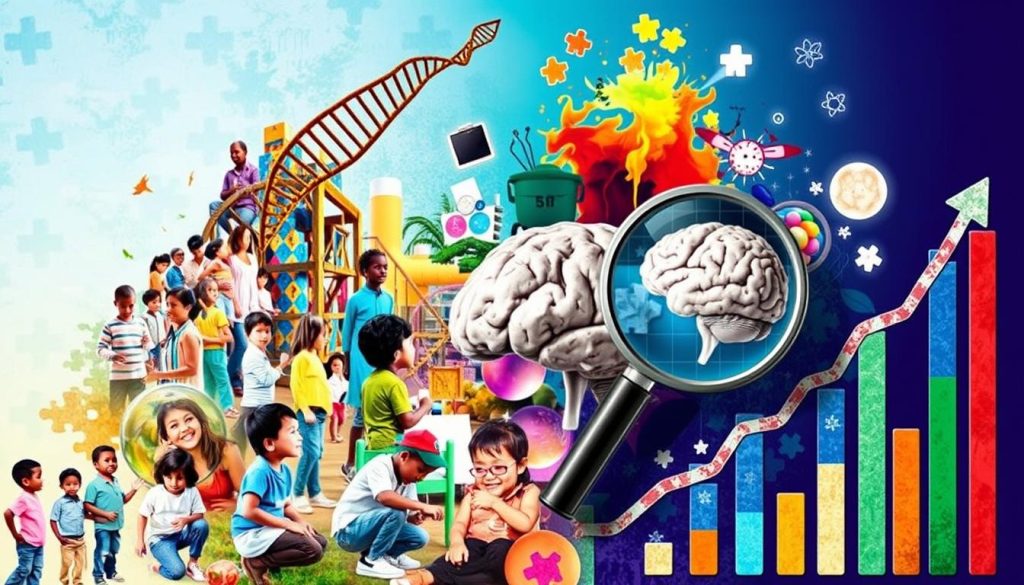
The rise in autism diagnoses has sparked debate among experts. Several factors have been identified as contributing to this increase. It’s important to understand these reasons to better support those with autism and their families.
Improved diagnostic criteria are a key factor. As we learn more about autism, more people are being diagnosed. This has led to concerns about an autism epidemic, but the term might be misleading.
Environmental factors are also being studied. Researchers look at how exposures during pregnancy and early childhood might affect autism. These include air pollution and certain medications.
- Increased awareness among parents and healthcare providers
- Expanded definition of autism spectrum disorders
- Better screening tools and earlier detection
- Changes in reporting practices and data collection
Genetic research has also shed light on autism. Scientists have found many genes linked to autism risk. This suggests a mix of genetic and environmental factors, which might explain why autism often runs in families.
Socioeconomic and cultural shifts have also played a role. Better access to healthcare and education programs have led to more diagnoses. These changes show a growing acceptance and understanding of neurodiversity.
Enhanced Diagnostic Methods and Their Impact
The rise in autism diagnoses is due to better diagnostic methods. These advancements help identify autism spectrum disorder more accurately. Let’s look at how modern methods have led to more autism diagnoses.
Modern Screening Tools and Techniques
New screening tools have changed how we detect autism. These include genetic tests, brain imaging, and behavioral assessments. These tools help diagnose autism earlier and more accurately, leading to more diagnoses.
Early Intervention Programs
Early intervention programs are key in addressing autism. They focus on supporting children with autism early on. This way, more children get diagnosed and treated on time.
Professional Training Improvements
Healthcare professionals now get better training in autism. Doctors, therapists, and educators learn to spot autism signs better. This leads to more accurate and frequent diagnoses.
| Diagnostic Method | Impact on Autism Diagnosis |
|---|---|
| Genetic Testing | Identifies autism risk factors |
| Brain Imaging | Shows autism-related neurological differences |
| Behavioral Assessments | Evaluates social and communication skills |
| Early Screening Programs | Detects autism signs in young children |
These better diagnostic methods have led to more autism diagnoses. They help us understand and address autism in our communities better.
Environmental Factors Contributing to Autism Rates
The rise in autism cases has led to a lot of research. Scientists are looking into what might cause this increase. They are focusing on how our environment could play a role in this complex condition.
Air pollution is a big area of study. Studies show that harmful particles can raise the risk of autism. Places with a lot of pollution have seen more autism cases, suggesting a link.

Chemical exposures are also a concern. Pesticides, plastics, and some pregnancy medications can affect brain development. This shows we need to look more into how toxins might cause autism.
Nutritional factors are important too. Not getting enough vitamin D during pregnancy can increase autism risk. This finding shows how important good nutrition is for brain development.
| Environmental Factor | Potential Impact on Autism Risk | Current Research Status |
|---|---|---|
| Air Pollution | May increase risk during pregnancy and early childhood | Strong evidence, ongoing studies |
| Chemical Exposures | Possible link to altered brain development | Mixed results, more research needed |
| Vitamin D Deficiency | Associated with higher autism risk | Promising findings, further investigation required |
These environmental factors give us clues about autism’s increase. But, it’s important to remember that autism is complex. Research is ongoing to understand its causes better.
Genetic Research and Autism Prevalence
Genetic research has uncovered the reasons for the autism upswing in recent years. Scientists have made big strides in understanding the complex genetic factors behind autism spectrum disorder (ASD).
Recent Genetic Studies
New studies have found over 100 genes linked to ASD. This discovery helps explain some of the factors behind the autism epidemic. It shows why autism often runs in families. Researchers believe both common and rare genetic variations contribute to autism risk.
Hereditary Patterns
Autism often appears in families. If one child has ASD, siblings are more likely to be diagnosed too. This pattern suggests a strong genetic link in autism’s development.
Gene-Environment Interactions
Genes don’t cause autism alone. They interact with environmental factors, creating a complex web of influences. This interaction may explain why autism rates vary across different regions and populations.
| Genetic Factor | Environmental Influence | Potential Impact |
|---|---|---|
| ASD-linked genes | Prenatal stress | Increased risk |
| Family history | Air pollution | Higher susceptibility |
| Rare mutations | Maternal infections | Altered brain development |
Understanding these genetic factors is key to explaining the rise in autism diagnoses. It gives us valuable insights into ASD’s complex nature. This knowledge helps us develop better diagnostic tools and targeted interventions.
The Role of Increased Awareness in Diagnosis Rates
Public awareness of autism has grown a lot in recent years. This growth has played a big role in the rise in autism prevalence. Now, more people know the signs and symptoms, helping parents and caregivers spot them in children.
Media coverage has been key in spreading autism information. TV shows, movies, and news reports have helped make autism more familiar. They’ve made it easier to talk about autism spectrum disorders.

Advocacy groups have also helped by organizing events and educational programs. Their efforts have led to more early screenings and interventions. This has resulted in more children being diagnosed.
Schools now teach about autism awareness in their classes. They focus on neurodiversity and acceptance. This change has helped students and teachers recognize autism traits better.
| Year | Autism Prevalence | Major Awareness Initiatives |
|---|---|---|
| 2000 | 1 in 150 | First World Autism Awareness Day |
| 2010 | 1 in 68 | Light It Up Blue campaign launched |
| 2020 | 1 in 54 | Nationwide autism screening programs |
The internet has become a great resource for parents looking for autism information. Online communities and forums offer support and share experiences. They encourage more parents to get their children evaluated by professionals.
Parental Age and Its Connection to Autism Risk
Recent studies have shown that parental age is linked to autism risk. Researchers are finding connections between a parent’s age and their child’s chance of autism.
Advanced Maternal Age Studies
Women having children later in life may face a higher autism risk. A study of over 5 million children found moms over 35 have a 30% higher chance of having an autistic child. This neurodiversity research helps explain the recent rise in autism.
Paternal Age Impact
Dads also play a role. Men over 40 are more likely to father a child with autism than younger fathers. Experts think this might be due to genetic changes in sperm as men age. Here’s how parental age affects autism risk:
| Parent | Age Group | Relative Risk |
|---|---|---|
| Mother | 20-29 | Base |
| Mother | 35+ | 30% higher |
| Father | 25-29 | Base |
| Father | 40+ | 28% higher |
While parental age is just one factor, it’s important to consider it when looking at autism trends. As people choose to have kids later, it may contribute to the increase in autism diagnoses.
Socioeconomic Factors Affecting Autism Detection
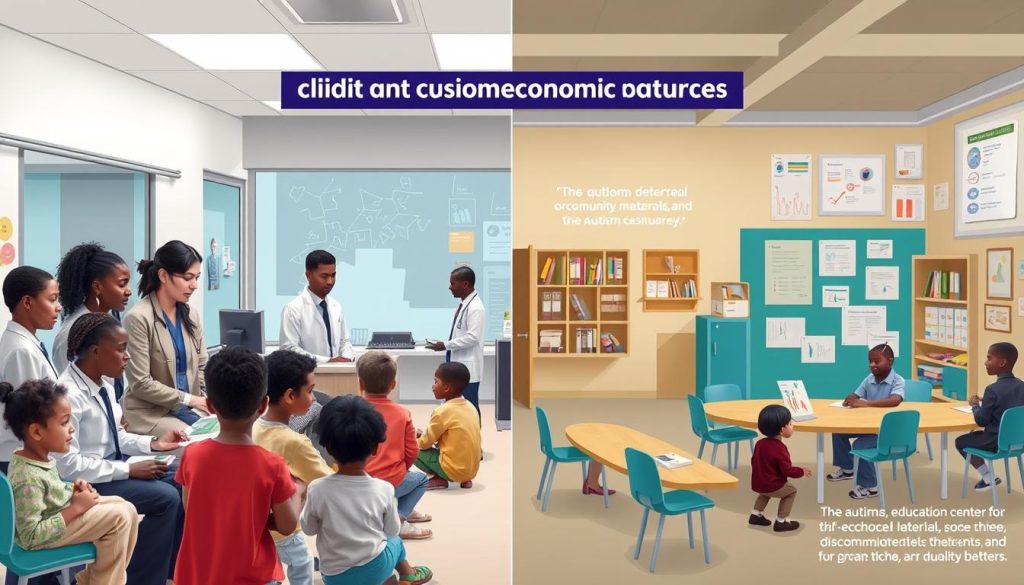
The number of autism cases in the U.S. is growing, but not evenly. Wealthier families often get their children diagnosed earlier. This is because they can afford better healthcare.
Poorer families face big challenges in getting their kids diagnosed. They might not have access to the right doctors or schools. This makes it harder for them to catch autism early.
Studies show that kids from rich families get diagnosed sooner. Getting help early can really change a child’s life. Here’s a table showing how income affects when kids get diagnosed:
| Annual Household Income | Autism Diagnosis Rate (per 1,000 children) | Average Age at Diagnosis |
|---|---|---|
| Less than $30,000 | 13.2 | 5.2 years |
| $30,000 – $60,000 | 15.8 | 4.7 years |
| $60,000 – $100,000 | 18.3 | 4.1 years |
| Over $100,000 | 22.1 | 3.6 years |
We need to make sure everyone has equal chances to get their kids checked for autism. Fixing these gaps could help us understand autism better. It could also improve the lives of kids from all backgrounds.
Changes in Special Education and Support Services
The number of autism diagnoses has gone up, leading to big changes in special education and support. These changes are key to understanding why more kids are being diagnosed with autism.
Educational Policy Evolution
School policies have changed a lot to help students with autism. Now, schools make special plans for each student. This helps autistic kids get the support they need.
Resource Allocation Changes
Schools are spending more on helping kids with autism. They are:
- Hiring more staff
- Buying new technology
- Creating spaces that are easier for autistic kids to learn
These efforts have made schools better for autistic students. It’s helped more kids get diagnosed.
Teacher Training Developments
Teachers are now learning a lot about autism. They know how to spot signs and help autistic students. This has led to more kids being diagnosed early.
| Year | Training Focus | Impact on Autism Diagnosis |
|---|---|---|
| 2000 | Basic autism awareness | Minimal impact |
| 2010 | Autism identification strategies | Moderate increase in referrals |
| 2020 | Comprehensive autism support techniques | Significant rise in early diagnosis |
These changes in special education and support have helped a lot. They ensure autistic kids get the help they need in school.
Geographic Variations in Autism Prevalence
The rise in autism rates is not the same everywhere in the United States. Different areas have different rates, showing how complex the issue is. It’s important to understand these differences to better support those affected and to improve research.
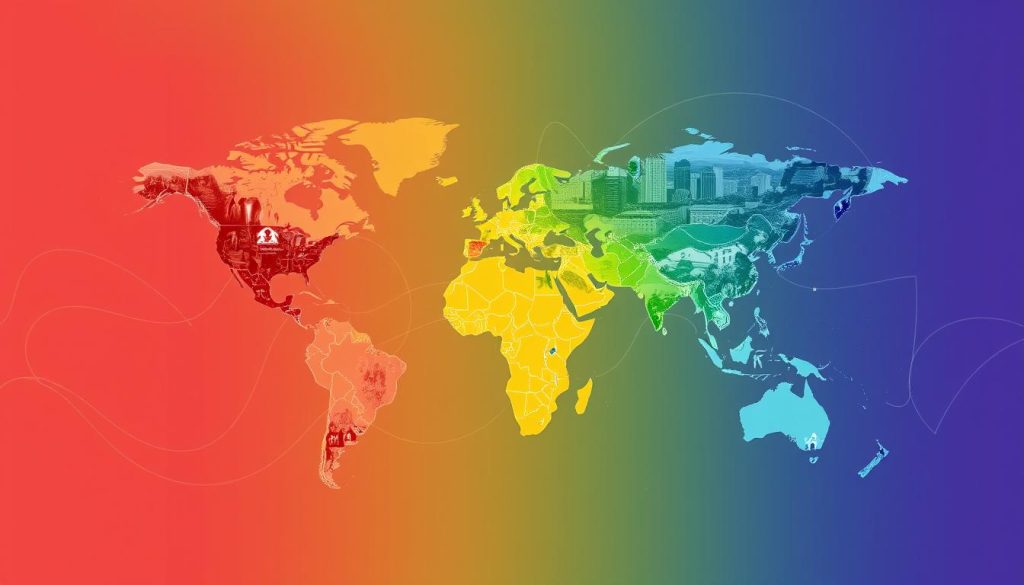
- Diagnostic practices
- Healthcare access
- Environmental influences
- Socioeconomic conditions
Looking at state-level data, we see big differences in autism rates. The table below shows these differences:
| State | Autism Prevalence (per 1,000 children) | Year |
|---|---|---|
| New Jersey | 31.3 | 2018 |
| California | 29.2 | 2018 |
| Texas | 20.4 | 2018 |
| Florida | 22.8 | 2018 |
These differences highlight the need for focused research. By understanding what causes autism in certain areas, we can create better early detection and treatment plans. This way, we can help more people and improve their lives.
The Impact of Modern Healthcare Systems
Modern healthcare systems have greatly helped in the rise of autism diagnoses. As autism trends change, better insurance and healthcare access have made a big difference. They help us identify and support people with autism more effectively.
Insurance Coverage Changes
In recent years, insurance has started covering autism-related services. This change has made it easier for families to afford diagnostic tests and therapies. Now, more parents can get professional help, leading to more autism diagnoses.
Healthcare Access Improvements
Improved healthcare access has been a big help in diagnosing autism. More clinics now offer autism services, cutting down wait times and barriers. This means families can get the help they need quicker, leading to more diagnoses.
The mix of better insurance and healthcare access has made a big difference for families with autism. These changes have not only increased autism diagnoses but also improved early help and long-term support for those on the autism spectrum.
Cultural Shifts in Autism Recognition
Society’s view on autism has changed a lot in recent years. This change is a big reason why more people are being diagnosed with autism. As we become more open to neurodiversity, the stigma around autism has dropped.
More parents and doctors are now considering autism as a possible cause for certain behaviors. This is because they feel more comfortable exploring this option.
The media has greatly influenced this cultural shift. TV shows, movies, and books are featuring characters with autism more often. These stories help people understand autism better.
This increased awareness is part of why we’re seeing more autism diagnoses. It makes people more likely to seek a diagnosis and support.
Schools and workplaces are also changing. They’re making their environments more inclusive for people with autism. This change encourages families to seek a diagnosis, knowing they’ll find support.
It’s important to remember that these cultural changes don’t mean autism is increasing. We’re just getting better at recognizing and accepting it.
As we continue to embrace neurodiversity, we may see even more increases in autism diagnoses. This trend shows our growing understanding and acceptance of different ways of thinking and behaving. It’s a positive sign that our society is becoming more inclusive and supportive of all its members.
FAQ
Q: Is autism actually increasing or just being diagnosed more often?
A: It’s likely a mix of both. Better ways to diagnose and more awareness have led to more cases. But, some research points to a real increase due to environmental and genetic factors.
Q: What are the main factors contributing to the rise in autism rates?
A: Several factors are at play. Improved diagnostic methods and awareness are key. Environmental changes, genetic research, and parental age also play roles. Socioeconomic factors affect access to healthcare and education.
Q: How have diagnostic criteria for autism changed over time?
A: Diagnostic criteria have changed a lot. Early criteria were narrow. But, modern criteria, like those in the DSM-5, cover a wider range of behaviors and symptoms. This has led to more inclusive diagnoses.
Q: Are there any environmental factors linked to increased autism rates?
A: Research is ongoing, but some environmental factors are being studied. These include certain chemicals, air pollution, and maternal stress during pregnancy. But, no single factor has been proven to increase autism rates.
Q: How does genetics play a role in the increase of autism diagnoses?
A: Genetic research has found many genes linked to autism risk. Hereditary patterns and how genes interact with the environment help us understand autism’s complex genetic basis. This may explain some of the increase in diagnoses.
Q: Does parental age affect the risk of autism in children?
A: Yes, studies show that older parents, both mothers and fathers, face a higher risk of having a child with autism. This may contribute to the rise in autism rates as people have children later in life.
Q: Are there geographic differences in autism prevalence?
A: Yes, autism prevalence varies across the United States. These differences might be due to differences in how autism is diagnosed, healthcare access, environmental factors, and demographics.
Q: How has increased awareness impacted autism diagnosis rates?
A: Increased awareness has greatly affected diagnosis rates. Public education, media, and advocacy have helped parents, educators, and healthcare professionals recognize autism symptoms. This has led to more children being evaluated and diagnosed.
Q: What role do socioeconomic factors play in autism detection?
A: Socioeconomic factors have a big impact on autism detection and diagnosis rates. Differences in healthcare access, educational resources, and diagnostic services across different socioeconomic groups can affect diagnosis likelihood.
Q: How have changes in special education services affected autism rates?
A: Changes in special education policies and services have helped increase autism diagnoses. Improved teacher training, resource allocation, and policy changes have made it easier to identify and support students with autism in schools.












